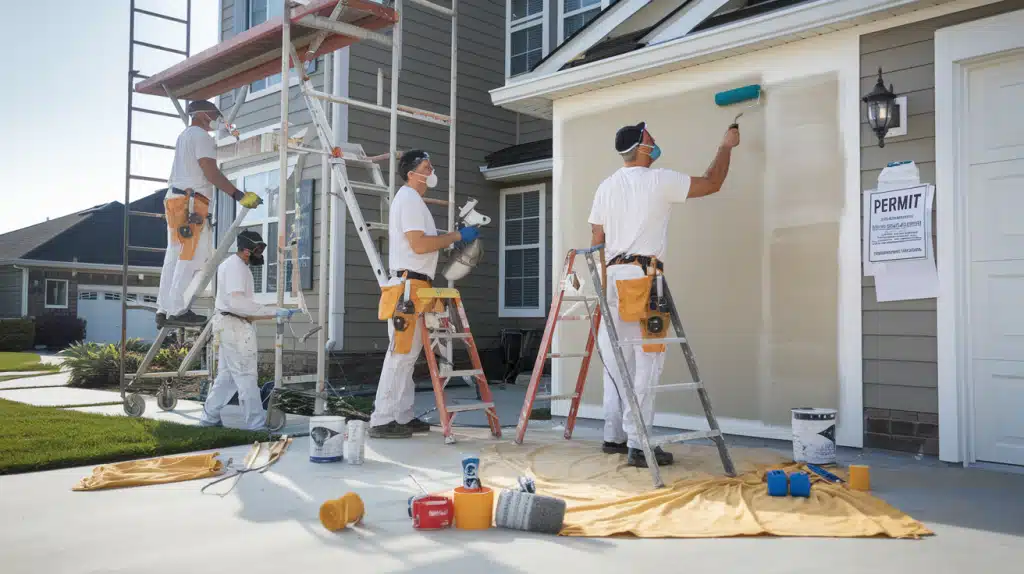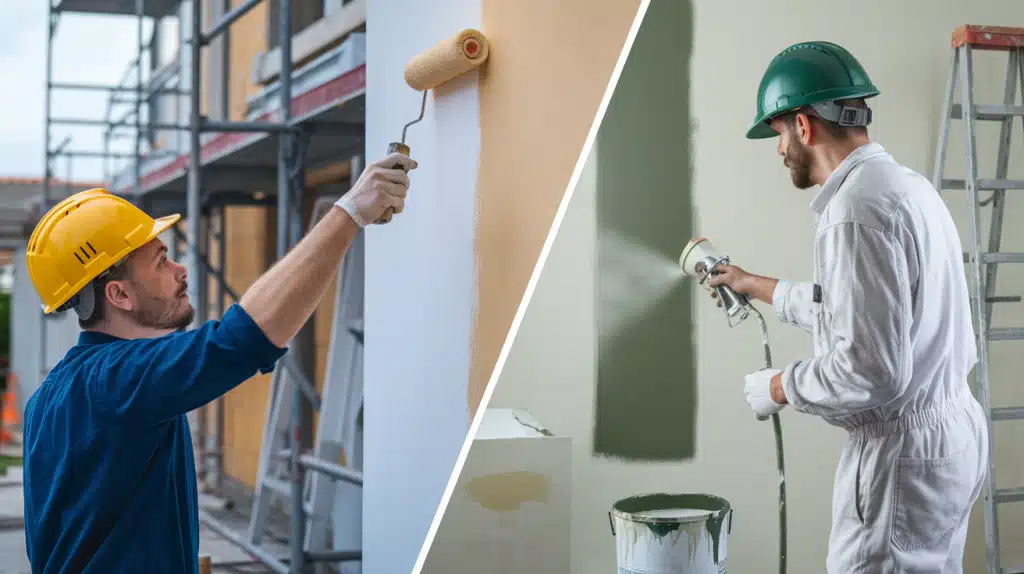Most homeowners feel shocked when they see their house’s peeling paint and faded colors. Painting costs can vary widely, making it hard to plan your budget.
What if you could know the exact expenses before starting your exterior painting project? Many factors affect the final price, from house size to paint quality.
Understanding these costs helps you make smart choices and save money. Our guide breaks down every expense, from materials to labor, giving you a clear view of what you’ll spend.
Read on to learn the true cost of exterior house painting. We’ll show you how to estimate your expenses and get the best value for your investment.
Cost of Exterior House Painting: A Complete Guide
Getting your house painted adds fresh appeal and needed protection. Understanding the costs helps you plan your budget well.
Cost per Square Foot
A standard exterior paint job runs between $2.50 to $4 per square foot. This price includes basic materials and labor.
The total cost changes based on your home’s size and condition. The paint quality and surface preparation also affect the final price.
Cost Range by House Size
Small homes under 1,500 square feet typically cost $3,000 to $5,000 to paint. Medium-sized homes between 1,500 and 2,500 square feet cost $4,500 to $8,000.
Large homes over 2,500 square feet can cost $7,000 to $12,000. These prices reflect professional painting services.
DIY vs. Professional Painting Cost Comparison
| Factors | DIY Painting | Professional Painting |
|---|---|---|
| Cost Range | $500 – $1,000 (materials only) | $3,000 – $12,000 (varies by house size) |
| Time Required | 2-3 weekends for average home | 3-5 days for average home |
| Equipment Needed | Must buy/rent all tools and supplies | All equipment included in price |
| Skill Level | Requires learning and practice | Expert level work guaranteed |
| Prep Work | Must handle cleaning and repairs | Included in service |
| Quality Assurance | Results may vary | Professional finish with warranty |
| Safety Concerns | Must manage ladder safety and heights | Includes insurance and safety equipment |
| Clean Up | Must handle disposal and cleanup | Complete cleanup included |
Factors Affecting Exterior Painting Costs
1. House Size and Surface Area
The size of your house directly affects painting costs. The more surface area to paint, the more materials and time needed.
Small homes need about 12 gallons of paint on average, while large homes may need 30 or more gallons. A single gallon covers approximately 350 square feet with one coat.
Wall height plays a significant role in cost calculations. Taller walls require special equipment and extra safety measures.
Single-story homes cost less to paint than two-story homes because they need fewer ladders, lifts, or scaffolding. These equipment requirements can add several hundred dollars to your total project cost.
2. Paint Quality and Type
Paint prices range from $25 to $100 per gallon, with quality making a big difference in long-term results. Basic exterior paint costs less upfront but often needs more coats for proper coverage.
Higher-quality paint provides better coverage and lasting protection, which saves money over time by extending the years between repaints.
Oil-based paints cost more than latex paints but offer superior weather resistance. The paint finish affects both price and appearance. Flat finishes hide surface imperfections but may show dirt more easily.
Satin finishes balance durability with appearance and cost. Gloss finishes highlight architectural details but cost more and show surface flaws more clearly.
3. Labor Costs and Regional Differences
Professional painter rates vary significantly by location. Urban areas typically command higher rates than rural regions due to increased operating costs and market demand.
In major cities, expect to pay 20-30% more than in smaller towns. The local cost of living directly influences these rates.
Seasonal timing affects painting costs too. The peak season runs from late spring through early fall when weather conditions are ideal.
During these busy months, prices often increase by 10-15%. Winter painting projects might cost less, but weather conditions can limit work days and extend project timelines.
4. Prep Work Needed
Surface preparation forms the foundation of a quality paint job. Professional cleaning services typically charge between $0.50 to $1 per square foot for thorough surface preparation.
This includes pressure washing to remove dirt, mold, and loose paint. Wood repairs cost extra, with typical rot repair running $100 to $300 per small affected area.
Proper preparation extends beyond cleaning. Contractors fill holes, repair cracks, and ensure all surfaces are ready for paint. This process takes time but prevents future problems.
Poor preparation leads to paint failure and costly repairs later. Most painters spend 50% or more of their project time on preparation work.
5. House Design and Complexity
Complex home designs require more time and skill to paint correctly. Multi-story homes need specialized equipment and extra workers for safety.
Intricate trim work around windows, doors, and rooflines demands careful attention and specialized techniques. These details often require smaller brushes and more precise work.
Architectural features like dormers, bay windows, and detailed cornices add complexity to the job. Each additional architectural element increases labor time and material needs.
Homes with many windows or doors need more time for cutting in around frames. These factors can increase the overall project cost by 25-50% compared to simpler home designs.
6. Location and Climate Impact on Costs
Your location influences paint costs beyond basic labor rates. Coastal areas need specialized paint formulas to resist salt spray and humidity.
These marine-grade paints cost 15-25% more than standard exterior paints but provide necessary protection. High-altitude locations need UV-resistant formulas to prevent sun damage.
Local regulations can also affect costs. Some areas require specific paint types or application methods. Historic districts often have strict rules about paint colors and techniques.
Lead paint removal, when required, must follow EPA guidelines and can add significant costs to older home projects.
Cost Breakdown: Labor, Materials, and Additional Expenses
1. Labor Costs vs. Material Costs
Painting contractors typically split their pricing between labor and materials. Labor makes up 70-85% of the total project cost. For a $5,000 paint job, expect to pay $3,500-$4,250 for labor.
The remaining $750-$1,500 goes toward materials. This split reflects the time-intensive nature of quality painting work.
Professional painters charge between $25 and $75 per hour. A team of two to three painters works 30-40 hours on an average-sized home.
This time includes surface preparation, painting, and cleanup. Experience level and local market rates influence labor charges. Most contractors include labor costs in their per-square-foot pricing rather than charging hourly rates.
2. Cost of Tools and Equipment
Equipment costs vary based on project needs and home size. Basic tools include brushes ($10-$20 each), rollers ($10-$25 each), and extension poles ($20-$50).
Professional-grade sprayers cost $200-$700, but they speed up work on large surface areas. Drop cloths, tape, and plastic sheeting add $100-$200 to material costs.
Safety equipment adds another layer of expense. Ladders cost $100-$300 each. Scaffolding rental runs $100-$200 per week. Personal protection gear like masks, goggles, and clothing costs $50-$100 per worker.
Professional painters include these costs in their estimates. DIY painters must buy or rent this equipment separately.
3. Permit Costs (if Applicable)
Some areas require permits for exterior painting. Permit fees range from $50 to $400, depending on your location and project scope. Historic districts often need special approval, which can cost more and take longer to obtain.
These permits protect property values and ensure work meets local standards.
Beyond basic permits, some locations require lead paint testing and special handling. Lead testing costs $200-$400. If lead paint exists, removal must follow EPA guidelines.
This specialized work increases project costs by $8-$15 per square foot. Always check local requirements before starting your project to avoid fines or work delays.
Ways to Save on Exterior Painting Costs
- Get Multiple Quotes from Contractors: Contact three to five painters for written estimates. Compare their prices, materials, and methods. Ask about their prep work plans and paint quality. A detailed quote helps you spot good value beyond just price.
- Choose the Right Season for Painting: Book your project in early spring or late fall to save 10-20% on costs. These seasons offer both lower rates and good painting weather. Avoid peak summer months when painters charge premium rates.
- Do Some of the Prep Work Yourself: Handle ground-level preparation to cut labor costs. Pressure wash walls, remove loose paint, and caulk around windows. Tell painters about your prep work when getting quotes. This reduces their work hours and your final bill.
- Buy Paint in Bulk or During Sales: Purchase five-gallon buckets instead of single gallons to save money. Watch for holiday sales offering 25-40% discounts. Join store loyalty programs for extra savings. Many stores accept returns of unopened paint if you buy too much.
When Should You Hire a Pro?
You should hire a professional painter when safety or quality concerns outweigh cost savings.
Two-story homes need special equipment and safety measures that most homeowners don’t have. Professional help makes sense when working at heights above 12 feet.
Time constraints also point toward hiring professionals. A painting crew finishes in 3-5 days what might take you several weekends.
If you need the job done quickly or have a strict deadline, professional painters offer speed and reliability.
Home condition matters too. Older homes often need repairs before the painting starts. Professionals spot wood rot, loose siding, and other problems early.
They know how to fix these issues properly. Their experience prevents small problems from becoming big ones.
Complex home designs benefit from professional skills. Houses with detailed trim, multiple colors, or special features need careful attention.
Professional painters have tools and methods for handling tricky spots. They create clean lines and even coverage in hard-to-reach areas.
Weather and climate can make painting tricky. Professional painters know when conditions are right. They understand how temperature and humidity affect paint drying. Their experience helps prevent weather-related paint failures.
Conclusion
A fresh coat of paint protects your home and makes it look its best. The cost of exterior painting depends on several key factors – from house size to paint quality.
While DIY painting offers potential savings, professional services provide expertise and proper tools for lasting results.
The choice between DIY and professional painting comes down to your specific needs. Consider your home’s size, design, and current condition.
Think about your available time, skill level, and comfort with heights. Factor in your local weather patterns and the best painting season in your area.
Understanding these elements helps you make informed decisions about your painting project. With proper planning and the right approach, you’ll achieve the results you want for your home’s exterior.


